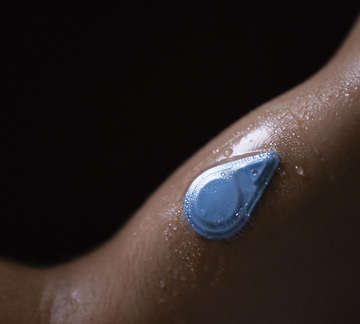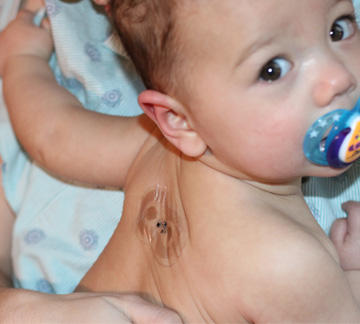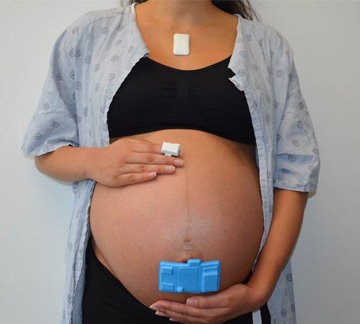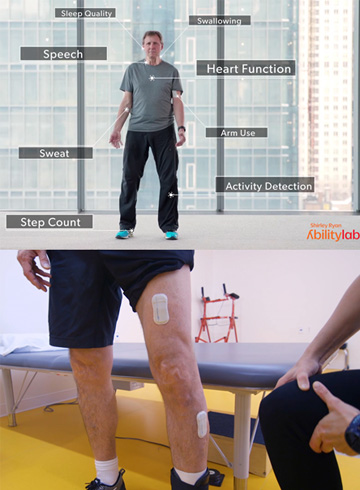 Soft, flexible, and skin-integrated QSIB sensors allow for a deep understanding of skin conditions. These systems have been used across a wide range of dermatological conditions from assessing skin barrier function to scratch frequency to UV-exposure. The technologies developed in QSIB have wide ranging implications across skin conditions including diagnosing disease, predicting disease flares, and tracking responses to treatment.
Soft, flexible, and skin-integrated QSIB sensors allow for a deep understanding of skin conditions. These systems have been used across a wide range of dermatological conditions from assessing skin barrier function to scratch frequency to UV-exposure. The technologies developed in QSIB have wide ranging implications across skin conditions including diagnosing disease, predicting disease flares, and tracking responses to treatment.
Collaborators:
- Northwestern Memorial Hospital
- Ann & Robert H. Lurie Children's Hospital of Chicago
Keywords: Atopic Dermatitis (Eczema); Scratch; Xerosis Cutis (Dry Skin); Melanoma
 QSIB works closely with pediatric experts at the Ann & Robert H. Lurie Children's Hospital of Chicago, one of the top children's hospitals in the nation. In the first and most fragile moments in life, QSIB’s wireless vital sign sensors monitor essential health data in a way that improves care and comfort. As children develop, the wireless sensors continue to monitor children’s development and health in a number of specialty areas including Neurology, Cardiology, Infectious Disease, Dermatology, and Respiratory Health.
QSIB works closely with pediatric experts at the Ann & Robert H. Lurie Children's Hospital of Chicago, one of the top children's hospitals in the nation. In the first and most fragile moments in life, QSIB’s wireless vital sign sensors monitor essential health data in a way that improves care and comfort. As children develop, the wireless sensors continue to monitor children’s development and health in a number of specialty areas including Neurology, Cardiology, Infectious Disease, Dermatology, and Respiratory Health.
Collaborators:
- Ann & Robert H. Lurie Children's Hospital of Chicago
Keywords: Allergy; Asthma; Atopic Dermatitis (Eczema); Cardiology; Cerebral Palsy; Dermatology; Epilepsy; Infectious Disease; Motor Development; Neonatal Intensive Care Unit (NICU); Neonates; Neonatology; Neurology; Pediatric; Pediatric Intensive Care Unit (PICU); Pulmonary; Respiratory Health; Scratch; Xerosis Cutis (Dry Skin)
 Neonatal health starts before birth with maternal health. QSIB wireless sensors are breaking new ground in offering expectant mothers hospital grade monitoring from home. In the hospital, QSIB aims to improve the maternal laboring experience with soft, flexible technology that is untethered to bulky equipment, providing greater comfort and mobility while offering heath care providers essential information to offer the best care.
Neonatal health starts before birth with maternal health. QSIB wireless sensors are breaking new ground in offering expectant mothers hospital grade monitoring from home. In the hospital, QSIB aims to improve the maternal laboring experience with soft, flexible technology that is untethered to bulky equipment, providing greater comfort and mobility while offering heath care providers essential information to offer the best care.
Collaborators: Northwestern Medicine Prentice Women’s Hospital
Keywords: Labor, Maternal, Obstetrics
 Tremendous technological progress over the past 3 decades gives us advanced computing and communication technology that fits in our pockets. QSIB aims to match that progress in healthcare with technology that meets personal healthcare needs from home to hospital. Devices are smaller, mobile, and more advanced.
Tremendous technological progress over the past 3 decades gives us advanced computing and communication technology that fits in our pockets. QSIB aims to match that progress in healthcare with technology that meets personal healthcare needs from home to hospital. Devices are smaller, mobile, and more advanced.
- Home Monitoring: Monitoring solutions that send your health data directly to doctors instead of sending you to the doctor. Head, heart, and body; our research aims to understand people’s individual health profiles and needs.
- Cardiology: Temporary cardiac pacemakers provide critical functions in pacing through periods of need during recoveries from cardiac surgeries. The percutaneous leads and externalized hardware associated with these devices represent, however, risks of infection and constraints on patient mobility. Surgical extraction procedures expose patients to additional risks and costs. Our wireless, bioresorbable pacemakers bypass these drawbacks to allow post-operative control of cardiac rate and rhythm during a well-defined stable operating timeframe, followed by complete dissolution and clearance via natural biological processes.
- Neurology: Patients with hydrocephalus, a common disorder associated with buildup of cerebrospinal fluid (CSF) in the intracranial space, have tubes and valves surgically implanted to relieve excess pressure. These devices work well but they have extremely high failure rates. Diagnosing malfunctions is challenging due to a combination of vague symptoms and a lack of a convenient means to monitor flow. Our wireless, wearable devices enable rapid, precise measurements of CSF flow, continuously or intermittently, in hospitals, laboratories or even in home settings, to reduce the need for expensive and time-consuming diagnostic procedures.
- Nephrology: Patients who receive kidney transplants live with risks of rejection episodes that can occur years after the transplant and can lead to complete failure of their new kidney. Our battery-free, wireless implants continuously track temperature and blood perfusion across the surfaces of the kidneys. The data from these devices provide early warning signs of inflammation associated with the initial stages of rejection events, thereby allowing for early medical interventions.
- Physical Rehabilitation: Stroke survivors often suffer from aphasia and/or dysphagia, conditions that involve the inability to speak and/or to swallow in a normal manner, respectively. Our soft electronic monitors gently mount onto the skin at the base of the neck, to capture speaking and swallowing events continuously and in real-time during natural daily activities. The resulting information allows rehabilitation specialists to tailor their protocols to the condition of each individual patient, in a personalized manner for improved outcomes.
Collaborators: Northwestern Memorial Hospital, Northwestern Memorial HealthCare, Shirley Ryan Ability Lab, Washington University in St. Louis
Keywords: Cardiology, Chronic obstructive pulmonary disease (COPD), COVID-19, Deep Vein Thrombosis (DVT), Depression, Geriatric, Home Monitoring, Neurology, Nursing Home, Obstructive Sleep Apnea (OSA), Parkinson’s Disease, Pulmonary Health, Sleep Medicine, Socialization, Speech and Language Therapy, Sweat, Talk time, Venous Leg Ulcers


 Soft, flexible, and skin-integrated QSIB sensors allow for a deep understanding of skin conditions. These systems have been used across a wide range of dermatological conditions from assessing skin barrier function to scratch frequency to UV-exposure. The technologies developed in QSIB have wide ranging implications across skin conditions including diagnosing disease, predicting disease flares, and tracking responses to treatment.
Soft, flexible, and skin-integrated QSIB sensors allow for a deep understanding of skin conditions. These systems have been used across a wide range of dermatological conditions from assessing skin barrier function to scratch frequency to UV-exposure. The technologies developed in QSIB have wide ranging implications across skin conditions including diagnosing disease, predicting disease flares, and tracking responses to treatment. QSIB works closely with pediatric experts at the Ann & Robert H. Lurie Children's Hospital of Chicago, one of the top children's hospitals in the nation. In the first and most fragile moments in life, QSIB’s wireless vital sign sensors monitor essential health data in a way that improves care and comfort. As children develop, the wireless sensors continue to monitor children’s development and health in a number of specialty areas including Neurology, Cardiology, Infectious Disease, Dermatology, and Respiratory Health.
QSIB works closely with pediatric experts at the Ann & Robert H. Lurie Children's Hospital of Chicago, one of the top children's hospitals in the nation. In the first and most fragile moments in life, QSIB’s wireless vital sign sensors monitor essential health data in a way that improves care and comfort. As children develop, the wireless sensors continue to monitor children’s development and health in a number of specialty areas including Neurology, Cardiology, Infectious Disease, Dermatology, and Respiratory Health. Neonatal health starts before birth with maternal health. QSIB wireless sensors are breaking new ground in offering expectant mothers hospital grade monitoring from home. In the hospital, QSIB aims to improve the maternal laboring experience with soft, flexible technology that is untethered to bulky equipment, providing greater comfort and mobility while offering heath care providers essential information to offer the best care.
Neonatal health starts before birth with maternal health. QSIB wireless sensors are breaking new ground in offering expectant mothers hospital grade monitoring from home. In the hospital, QSIB aims to improve the maternal laboring experience with soft, flexible technology that is untethered to bulky equipment, providing greater comfort and mobility while offering heath care providers essential information to offer the best care. Tremendous technological progress over the past 3 decades gives us advanced computing and communication technology that fits in our pockets. QSIB aims to match that progress in healthcare with technology that meets personal healthcare needs from home to hospital. Devices are smaller, mobile, and more advanced.
Tremendous technological progress over the past 3 decades gives us advanced computing and communication technology that fits in our pockets. QSIB aims to match that progress in healthcare with technology that meets personal healthcare needs from home to hospital. Devices are smaller, mobile, and more advanced.